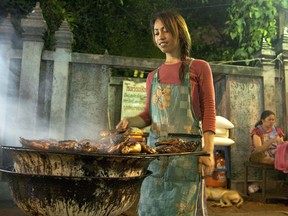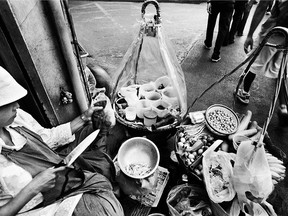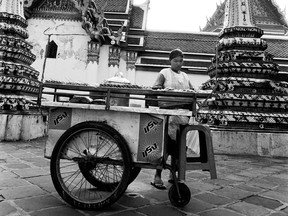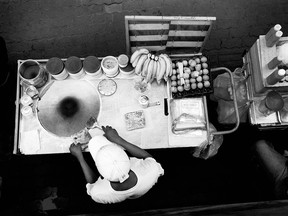
Eating at the numerous food stalls and vendor carts can turn a stroll along Bangkok’s streets into a culinary adventure.

Reviews and recommendations are unbiased and products are independently selected. Postmedia may earn an affiliate commission from purchases made through links on this page.
Article content
Twilight, and a golden sun hovers above a skyline of ornate skyscrapers and temple spires in Thailand’s seductive capital, Bangkok. Down in the old part of the city a procession of saffron-robed monks slowly files past the gleaming architecture of the Grand Palace, while brightly coloured tuk tuks (three-wheeled motorcycle taxis or auto rickshaws) buzz about like angry bees, their eager drivers on the lookout for new customers.
Advertisement 2
Article content
Towards the end of one road near the Grand Palace, enterprising food vendors have set up a cluster of stalls, transforming the street corner into a food bazaar. Tantalising aromas drift from sidewalk kitchens serving up sizzling Thai delights. Locals and travellers sit on colourful plastic stools at colourful plastic tables where the dining is a rowdy cheek-by-jowl affair. Outside one stall, a woman wields a wok of prawns and vegetables on her gas burner, creating a medley of smoke and flickering flames.
Article content
Another street vendor pushes his glass-fronted food cart bulging with spiky durian fruit into position next to someone busily arranging squid satays on a charcoal stove A few metres away, a wizened old lady bends over a large stone mortar, pounding grated papaya, nuts and chilies to prepare a hot and tangy som tam (papaya salad).

At first glance the street looks more like a food fair than a thoroughfare, but it’s a scene repeated throughout the city, where every alleyway wide enough to hold a wok or deep fryer is claimed as a makeshift restaurant. From Yaowarat Road in Chinatown, to Khao San Road in Banglamphu, the sidewalk eateries and mobile food carts speak the spirit of Bangkok in the same way as pubs do for Dublin, cafés for Paris or diners for New York.
Article content
Advertisement 3
Article content
What is Thai street food?
Standing at an important Asian crossroads for centuries, Thailand owes its rich cuisine to the culinary infusions of India, China, Malaysia and Indonesia. It has adapted cooking techniques and ingredients from each of these major influences and blended them with its own.
Street food is the lifeline of Asia, helping feed millions of people daily, and Bangkok is certainly no exception. The first wave of travellers in the 70s discovered it was a cheap and delicious way to eat and initiated the process of popularising Thai food as one of the world’s great cuisines.
The characteristic flavours of Thai food comes from a blend of four basic tastes – salty, sweet, sour and pungent, and the liberal use of ingredients such as fresh coriander leaf, lemongrass, lime juice, garlic, chilies, tamarind juice, fish paste, ginger and coconut milk. Sidewalk gourmets are masters at combining these ingredients and employing fast cooking techniques that maintain the delicate flavours of the food. Before you can say moo ping or phat Thai, they will char-grill you some skewers of marinated pork or stir-fry some rice noodles with bean sprouts, peanuts, eggs and chili.
Advertisement 4
Article content
Although there are some world-class gourmet restaurants in the city, there is so much variety of food on the streets that you can literally go weeks without even stepping inside one. Ask any Bangkokian to take you to their favourite restaurant, and you’ll most likely be eating street side at some open-air cart.
Follow their example and graze from the informal buffet of street fare while having your senses challenged with the live street theatre – pungent aromas of chili, garlic and barbecued fish, the cacophony of music, lights and voices and the spectacle of accomplished chefs at work, wielding their utensils with awesome dexterity.

Vendors tend to specialize in one dish: noodles, salads, curries, barbecued meat or fish, rice dishes, fruit juices, sweets etc. Some favourites include kai ho bai toei (seasoned fried chicken in leaf wrappers), thotman plakrai or thotman kung (fish or shrimp fritters Thai style) various kinds of yam (Thai salads) tomyam (hot and sour soup) and gaeng kiow wan gai (green chicken curry).
For something sweet to finish off your street dining, look out for khao niew mamuang (sticky rice with mango), kruay kaek (banana fritters), or simply choose from a selection of sliced fresh fruits from one of the roaming carts. The fruit is slipped into a small plastic bag along with a bamboo skewer to spear the fruit with, and an accompanying mixture of salt, sugar and powdered chili to dip the fruit in.
Advertisement 5
Article content
Thai pushcarts deliver meals on wheels
If you don’t want to go to the food, let the food come to you. The methods of transporting the ingredients to make a meal are as varied as the dishes themselves. Hawkers on foot can be spotted just about anywhere from crossing a busy intersection to doing a brisk trade outside a monastery. Bearing filled baskets balanced on a wooden yoke upon one shoulder, they haul around noodles, vegetables, spices, plates, a small stove and a stool- all the paraphernalia needed to create a sit-down roadside meal for a hungry diner.

Another common spectacle along the streets of Bangkok is the pushcart or tricycle cart, a simple variant of the bicycle or motorcycle pushing a large wheeled box containing everything needed to make delicious food. Along the canals and waterways, sellers paddle their mini-shops from home- to-home, offering “boat noodles,” curries over rice and an assortment of kanom (sweetmeats and snack foods).
The city’s food carts may be humble, and the dishes may be cheap, but the clientele come from all walks of life. From well-heeled businessmen to people who sweep the streets, most Bangkokians eat at these one-dish specialist stalls, perched on tiny stools as the traffic hurtles by, because they provide the freshest, most authentic and delicious Thai cooking.
Whether you are new to the charms of Thai food or a veteran when it comes to knowing the difference between phad thai or gaeng kiow wan gai, next time you’re in Bangkok explore the world of the city’s sidewalk gourmets – the unsung heroes of Thai cuisine.
Article content